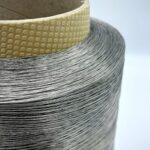Faster entry into textile reinforced concrete market
Martin Scheurer, a doctoral candidate of the Institut für Textiltechnik (ITA), has been awarded the Hanns Voith Foundation Prize 2019 in the New Materials category last month, in Heidenheim, Germany, with prize money of EUR 5,000. Mr Scheurer receives the prize for his master thesis, Development of a method for evaluating the suitability of textiles for use in textile-reinforced concrete.
In his thesis, Mr Scheurer investigates how textiles can be used in textile-reinforced concrete.
Shorter and faster
So far, testing the suitability of new textiles for use in textile-reinforced concrete has been very time-consuming and expensive: the current approval process for textiles in textile concrete requires an intensive testing programme of over 50 different tests.
With the method developed by Mr Scheurer, only three different tests are necessary to make a good initial assessment of the suitability of textiles for use in textile-reinforced concrete. Mr Scheurer now enables companies to find an initial assessment of the suitability of their textiles for use in textile-reinforced concrete within a period of approximately one month, which is relatively inexpensive.
The target group for this newly developed method is textile manufacturers who want to enter the growing textile reinforced concrete market. The use for textiles manufacturers is the lowering of market entrance barriers. An enterprise can find out now fast whether the entrance into the textile reinforced concrete market with existing textiles is possible.
Textile reinforced concrete
Textile reinforced concrete is a new material with the potential to revolutionize the construction industry. In textile-reinforced concrete, the traditional steel reinforcement is replaced by high-performance textiles made of glass or carbon fibres. The use of textile reinforced concrete as a material makes thin concrete elements possible since the textiles, unlike steel, do not rust and therefore much less concrete has to be used as protection against corrosion.
This saves material, weight and carbon dioxide. Since cement production for the production of concrete causes three times as much carbon dioxide as global aviation, at 6.5% of CO2-emissions, the use of textile concrete is considered to be highly environmentally friendly.
In addition, the use of textile concrete allows greater freedom of de-sign due to the simple formability of the textiles and thus offers new architectural possibilities.
Source: Innovation in Textiles













